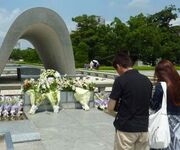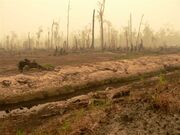Seoul was a city of approx. 9.3 million before Doomsday. It was located at the latitude and longitude of 37°34 N and 127°00 E respectively. It was hit at approximately 19:32 AM Korean Standard Time, or 10:32 UTC by a single SS-18 "Satan" ICBM, which air-burst over Seoul with a yield of 500 KT, or over 30 Hiroshima-sized weapons. Seoul and its surrounding environs were affected severely by Doomsday, with millions dead and dying. Almost the entire populace was killed, with refugees streaming out to the countryside.
Pre-Doomsday[]
Seoul has a 2000 year history stretching back to 18 BC. It has been the capital of numerous Korean kingdoms, empires, and others, including the late Republic of Korea. The city was protected by massive walls and has several old castles and palaces right next to modern high-rise buildings and the famed Korean PC Baangs (PC 방), or PC rooms. Seoul was the capital of the Republic of Korea, which by Doomsday was an ally of the US with heavy US influence. It held 40,000 US troops, and was therefore nuked by the USSR on that fateful day.
Doomsday[]
Doomsday proved devastating for South Korea, and the entire nation descended into chaos as North Korea proceeded to invade its southern counterpart. Seoul, being the capital of South Korea, as well as the headquarters for the military, was the primary target. South Korea itself was hit in five locations: Seoul, Pyongtaek, the US Air Force HQ that was garrisoned there, Gunsan, another major air force base, and the US navy base in Chinhae. The North Korean capital of Pyongyang had also been hit, although its leader, Kim Il-Sung, was still alive due to the early warning the bombardment of South Korea provided. He has sought refuge in a bunker twenty miles out when Pyongyang was hit, and was therefore safe. He later emerged into a ruined North and South Korea. He later said in a speech to both North and South Korea, "It is time to unite the Korean peoples under one banner, one government, one rule." He had a standing ovation that reportedly lasted for over 14 minutes.
Post-Doomsday[]
Northern Invasion[]
North Korea seized the advantage by invading South Korea with a focus on speed and resilience, pushing the South back as far as, in some places, as much as 82 miles. Due to the fact that most of the South Korean leadership had been killed, in comparison to their Northern colleagues, meant that local officers organized resistance in the region, and as a result, it was not very coordinated at first.
The first and hardest hit it the attack was Incheon, near Seoul, and one of the closest cities to the border. The famed Incheon International Airport was completely destroyed, and the entire city was in ruins. Most of the fighting took place in the Incheon area, with thousands of casualties on both sides. It is estimated that a combined 11,000 military personal died in Incheon, not including civilians.
However, catastrophe struck the North, in the form of a Chinese "invasion". Wave after wave of Chinese refugees began pouring into North Korea, escaping the devastation back home due to the Soviet nuclear strikes. The South was spared, as that it had no land borders with any country except for North Korea, and because much of its coast was irradiated, which discouraged refugees coming in from that direction. This momentarily disrupted the North Korean offensive, saving both the Seoul region and the nation itself. South Korea began pushing them back. Soon, the front was back to roughly the pre-Doomsday borders, with the South continuing to push northwards, though unable to launch an outright invasion in light of the attacks.
Ceasefire[]
In 1983, Seoul had a population of 9.3 million and was well on its way to becoming a prominent metropolis in Asia. Immediately after Doomsday however, the population had declined to around 20,000, and gradually shrank as the background radiation forced many to move away, explaining its present-day population of roughly a hundred. However, most of these people live in buildings that have either no electricity, plumbing, etc, or with some structural damage from the nuclear blast.
However, Seoul was not the only one affected. While all the other targets were military targets, about 60% of South Korea's population lived within an hours distance of Seoul. This led to massive casualties as the radiation spread from the ghost town. As the North Korean army advanced, they took Inchon and the surrounding area, and were nine miles from the smoldering wreckage of Seoul when Kim Il-Sung sounded a general retreat due to the refugee problem. This led to a ceasefire being instituted.

A building in Seoul
Aftermath of Doomsday[]
Doomsday had extreme consequences for South Korea, North Korea, and especially Seoul itself. Seoul was hit by a SS-18 Satan ICBM fitted with a 500 KT nuclear warhead. In the first few seconds, 6.2 of the 9.3 million inhabitants perished instantly, and in the next few weeks, around another three million people died from radiation, burns, or other effects of the blasts.
Seoul was seen as a symbol of the old days of prosperity, but it also has, in recent years, became a symbol of unification with the formation of the Korean Union. Both Kim and the Southern government wanted to rebuild Seoul and use it as their capital, but they recognized that the radiation was too great and so the capital was set up in Kaesong, one of the oldest cities in Korea, instead.
Seoul and South Korea Today[]
Seoul today is a shadow of its former self. The center of it is basically an irradiated hole, while the some parts of the outside are fairly intact. However, it is not known whether Seoul will ever be rebuilt, despite laws passed in the Korean Parliament.

The War Memorial in Kaesong for Seoul
Popular Culture[]
Seoul has been turned into a kind of legend by the current generation, a memory of the times before unification and Doomsday. Movies, books, magazines have been made about Seoul. One noteworthy movie/documentary, called 꿈의 도시, or The City of Dreams, grossed over 600 million ANZC $. Another noteworthy publication was 서울의 죽음, or The Fall of Seoul, which sold over 3 million copies. Recently, there has been a revival in interest for Seoul and several groups, including 심장, or The Heart, based in the villages outside Seoul, have been pressuring the government to step up plans to rebuild Seoul.
Nuclear Fallout[]

Scorched Earth near Seoul
There is still much fallout in Seoul and the surrounding area, and cancer rates have gone dangerously up in the last few years. However, it shows signs of subsiding, and plans have been made to map out the ruins of Seoul in fallout suits. It is planned that parts of Seoul could be started to be rebuilt by 2030, but opinions differ on the matter. Recently, the Korean National Parliament has passed a law that said that Seoul will be started to be rebuilt, at its latest, at 2065. However, the city itself will not be completely habitable for at least a century post- doomsday.
| ||||||||||||||||||||||

